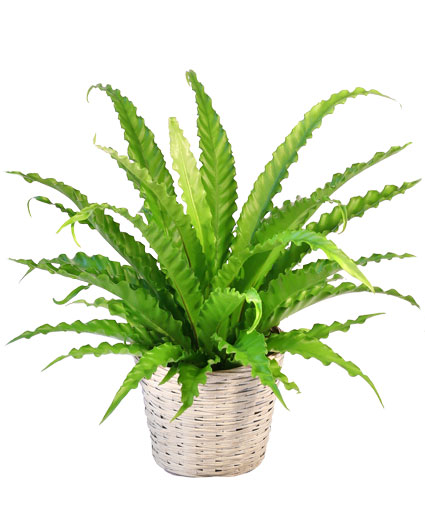Bird's Nest Fern (Asplenium nidus)
Last
updated: August 3,
2025
Care
Sheet List
The
Bird's
Nest Fern is a popular houseplant admired for its bright green,
wavy-edged
fronds that grow in a circular, rosette pattern resembling a bird's
nest.
It's an epiphytic fern, meaning it grows on other plants in its natural
rainforest habitat, not in soil.
Lighting
Bird's
Nest
Ferns prefer medium to low indirect light.
- Ideal: A spot near an
east or north-facing window is excellent, providing gentle light. They
can also thrive a few feet back from a brighter south or west-facing
window, ensuring they are shielded from direct sun.
- Benefits: Consistent
indirect light encourages vibrant green fronds and healthy growth.
- Avoid: Direct
sunlight will quickly scorch their delicate fronds, leading
to brown, crispy patches. Too little light can result in dull, stunted
growth.
Watering
Routine
Bird's
Nest
Ferns like consistently moist soil but absolutely cannot
tolerate soggy
conditions or sitting in standing water, which leads to root
rot.
- Frequency: Water when the top
1-2 inches of soil feel slightly dry to the touch. Do not
allow the soil to dry out completely.
- Method: Water
thoroughly around the base of the plant, avoiding pouring water
directly into the "nest" or crown of the fern. Water accumulating in
the center can cause rot. Water until you see water draining from the
bottom of the pot. Discard any excess water from the saucer immediately.
- Seasonality: Reduce watering
frequency in fall and winter when the plant's growth slows.
Fertilizer
Requirements
Bird's
Nest
Ferns are light feeders. Too much fertilizer can easily burn their
sensitive roots.
- Schedule: Fertilize
sparingly, only during their active growing season, which is typically
from spring through early fall. Once every 4-6
weeks is sufficient.
- Type: Use a balanced
liquid houseplant fertilizer.
- Commercial Recommendation: Miracle-Gro
Indoor Plant Food (Liquid) or Schultz Liquid Plant
Food are easily available options. Dilute these commercial
concentrates to achieve approximately 25-50 ppm N in your final
solution. This is often equivalent to using them at "half strength" or
even "quarter strength" of the package's recommended "full strength"
for general houseplants. Always dilute more than the package recommends
for most ferns.
- DIY Fertilizer Suggestion: If using your homemade 1-1-1
liquid fertilizer concentrate, apply at the "Light Feeding" rate.
This means adding 5 ml of your 1-1-1 concentrate per 1 liter of
water, which provides approximately 50 ppm N, 50 ppm P₂O₅, and
50 ppm K₂O. This balanced, gentle feeding is ideal for Bird's Nest
Ferns.
- Avoid: Do not
fertilize in late fall and winter.
Misting
Requirements
Bird's
Nest
Ferns are tropical plants and love high humidity.
This is a
crucial factor for their health and to prevent the frond edges from
turning
brown and crispy.
- Recommended: Aim for
humidity levels of 50% or higher.
- Methods:
- Misting: Mist the
foliage regularly, daily or every other day, with room-temperature
water.
- Pebble Tray: Place the pot
on a pebble tray filled with water (making sure the pot is not sitting
directly in the water).
- Humidifier: Using a room
humidifier nearby is highly effective, especially in dry environments.
- Grouping: Grouping your
fern with other plants can help create a more humid microclimate.
Pot Size
and Soil Type
- Pot Size: Bird's Nest
Ferns have relatively shallow root systems. When repotting (best done
in spring), choose a pot that is only 1-2 inches larger in
diameter than its current one. They prefer to be slightly
root-bound. Ensure the pot has excellent drainage holes.
- Soil Type: Use a well-draining,
airy, and peat-based potting mix that retains some moisture.
A standard houseplant potting mix can be easily amended to suit their
needs.
- A good recipe
would be:
- 2 parts
all-purpose potting mix
- 1 part perlite
- 1 part orchid
bark or coarse coco coir
- This mix
provides the necessary drainage and aeration, mimicking their natural
epiphytic growing conditions while holding sufficient moisture.
Special
Notes:
- Handle Fronds
Carefully:
Avoid touching
the new, unfurling fronds in the center, as they are very delicate and
can easily be damaged, which may leave permanent marks.
- Crown Rot: Always avoid
getting water in the central "nest" of the fern, as this can lead to
crown rot, which is often fatal.21 Water around
the edges of the soil.


